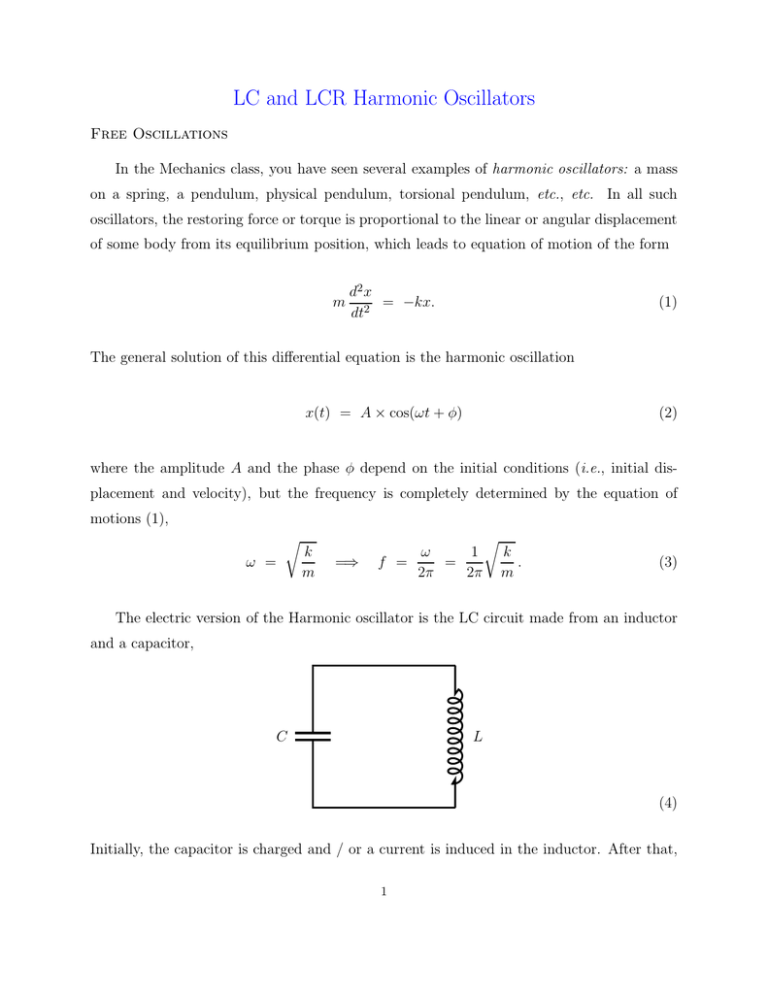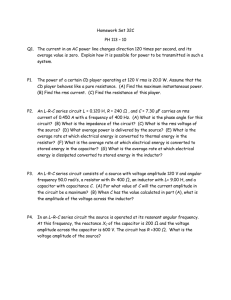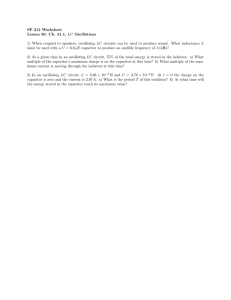Oscillations and resonance in LC and LCR circuits
advertisement

LC and LCR Harmonic Oscillators Free Oscillations In the Mechanics class, you have seen several examples of harmonic oscillators: a mass on a spring, a pendulum, physical pendulum, torsional pendulum, etc., etc. In all such oscillators, the restoring force or torque is proportional to the linear or angular displacement of some body from its equilibrium position, which leads to equation of motion of the form m d2 x = −kx. dt2 (1) The general solution of this differential equation is the harmonic oscillation x(t) = A × cos(ωt + φ) (2) where the amplitude A and the phase φ depend on the initial conditions (i.e., initial displacement and velocity), but the frequency is completely determined by the equation of motions (1), ω = r k m =⇒ ω 1 f = = 2π 2π r k . m (3) The electric version of the Harmonic oscillator is the LC circuit made from an inductor and a capacitor, C L (4) Initially, the capacitor is charged and / or a current is induced in the inductor. After that, 1 the current and the voltage oscillate harmonically according to V = Vmax × cos(ωt + φ), I = Imax × cos(ωt + φ + 90◦ ). (5) To see how it works, note that the capacitor discharges (or gets charged) through the inductor, so the current I in the inductor and the charge Q on the capacitor are related as I(t) = dQ dt (6) Consequently, the voltage on the inductor is related to the second time derivative of the charge as VL (t) = −L d2 Q dI = −L 2 . dt dt (7) However, in the LC circuit, the voltage on the inductor must be the same as the voltage on the capacitor, thus VL = VC = Q . C (8) Comparing the last two equations, we see that −L × d2 Q 1 = VL = VC = × Q(t). 2 dt C (9) This second-order differential equation for the charge has the form Of the harmonic oscillator equation (1), so its general solution is the harmonically oscillating charge Q(t) = Qmax × cos(ωt + φ). (10) The amplitude Qmax and the phase φ of the oscillating charge depend on the initial conditions, but the frequency of the oscillation is completely determined by the equation (9). 2 Indeed, d2 Q = −ω 2 × Qmax × cos(ωt + φ) dt2 (11) so eq. (9) needs 1 × Qmax × cos(ωt + φ) C +Lω 2 × Qmax × cos(ωt + φ) = (12) and therefore Lω 2 = 1 C =⇒ ω = √ 1 . LC (13) Or in terms of the cyclic frequency, f = 1 ω √ = . 2π 2π LC (14) For example, for C = 1.0 µF and L = 1.0 mH, ω = p 1 (1.0 · 10−6 F) × (1.0 · 10−3 H) = √ 1 1.0 · 10−9 s2 = 31.6 · 103 s−1 (15) (note units: (1 F) × (1 H) = 1 s2 ), hence the cyclic frequency f = ω ≈ 5.0 kHz. 2π (16) Given the harmonically oscillating charge (10), the voltage and the current in the LC circuit also oscillate according to eqs. (5). Indeed, Q(t) Qmax = × cos(ωt + φ), C C (17) dQ = −ωQmax × sin(ωt + φ) = +ωQmax × cos(ωt + φ + 90◦ ). dt (18) V (t) = while I(t) = Note: the current’s phase is 90◦ — i.e., 1 4f — ahead of the voltage’s, as shown on the 3 following diagram I, V t Finally, consider the energy of the harmonic oscillator. The energy of the charged capacitor is UC = Q2 Q2 = max × cos2 (ωt + φ). 2C 2C (19) The energy of the inductor carrying current is UL = L L × I2 = × ω 2 Q2max × sin2 (ωt + φ) 2 2 (20) where L × ω 2 = 1/C, cf. eq. (13). Consequently, adding the two energies gives us Unet = UC + UL Q2 Q2max 2 2 × cos (ωt + φ) + sin (ωt + φ) = 1 ≡ max . = 2C 2C (21) Thus, the net energy is constant — as it should be since there is no dissipation in a pure LC circuit — but it moves from the capacitor to the inductor and back to capacitor every 4 half-period of the oscillation. UC (t), UL (t), Unet t Damped Oscillations Ideally, once a harmonic oscillator is set in motion, it keeps oscillating forever. In real life, this does not happen because there is always some kind of a friction, or more generally, some kind of energy loss. Consequently, the oscillation amplitude slowly diminishes with time and eventually the motion stops altogether. In the electric case, the primary cause of the energy dissipation in the LC circuit is the resistance of the wires making up the inductor, although there could be other causes: hysteresis in the iron core of the solenoid, leakage of the dielectric in the capacitor, etc., etc. For simplicity, let us focus on the resistance and consider the RLC circuit R C L (22) The Kirchhoff Law of Voltages for this circuit reads dI Q + R×I + L× = 0, C dt 5 (23) or in terms of the time-dependent capacitor charge Q(t), 1 dQ d2 Q × Q(t) + R × + L × 2 = 0. C dt dt (24) This is a linear second-order differential equation with constant coefficients, and its general solution is Q(t) = A × cos(ωt + φ) × exp(− 21 γt) (25) where the initial amplitude A and the phase φ depend on the initial conditions but the frequency ω and the decay rate γ are determined by the R, L, and C. To see how this works, note that the general solution to any linear differential equation with constant coefficients — real or complex — is either an exponential x(t) = A × exp(αt) for some α (which may be complex), or a sum of several such exponentials x(t) = A1 × exp(α1 t) + A2 × exp(α2 t) + · · · + An exp(αn t) (26) where n is the order of the equation. To find the α1 , . . . , αn exponents, one plugs a single exponential A × exp(αt) into the differential equation, which reduces it to a polynomial equation for the α. Let’s apply this general rule to the second-order equation (24) and plug in Q(t) = A×eαt . This gives us 1 × Aeαt + R × α × Aeα t + L × α2 × Aeαt = 0 C (27) and therefore a quadratic equation for the α: L × α2 + R × α + 1 = 0. C (28) For small R, the two roots of this equation are complex, α1,2 r 1 R2 R ± i − , = − 2L LC 4L2 6 (29) or equivalently, α1 = − γ + i ω, 2 α2 = − γ − iω 2 (30) where γ = L , R ω0 = √ 1 , LC and ω = q ω02 − 41 γ 2 . (31) Since there are two roots α1 and α2 , the general complex solution of the equation (24) is Q(t) = A1 × exp(α1 t) + A2 × exp(α2 t) = A1 × ei ωt + A2 × e−iωt × e−γt/2 (32) for any complex A1 and A2 . But since we need a real solution, this requires A2 = A∗1 , or equivalently A1 = 21 Aeiφ , A2 = 21 Ae−iφ for some real A and φ, and hence Q(t) = iφ+iωt 1 2A × e + −iφ−iωt 1 2A × e × e−γt/2 = A × cos(ωt + φ) × e−γt/2 (25) Graphically, Q t √ Physically, ω0 = 1/ LC is the frequency of the un-damped purely-LC oscillator, ω = q ω02 = (γ/2)2 is the slightly smaller oscillation frequency of the dumped RLC oscillator, 7 and γ is the energy decay rate. Indeed, interpreting A × e−γt/2 = Qmax (t) (33) as a decaying amplitude of the harmonic oscillations, the net oscillator energy decreases with time as U(t) = Q2max A2 = × e−γt . 2C 2C (34) In other words, the energy decays exponentially at the rate γ: in time τ = 1/γ, the oscillator loses 63% of its initial energy, in the nets ∆t = τ , it looses 63% of the remaining energy, etc., etc. For example, consider the RLC circuit with L = 1.0 mH, C = 1.0 µF, and R = 1.0 Ω. For this circuit, R 1.0 Ω = = 1.0 · 103 s−1 −3 L 1.0 · 10 H γ = (35) while ω0 = √ 1 = 31.6 · 103 s−1 LC (36) and q ω = ω02 − (γ/2)2 ≈ ω0 = 31.6 · 103 s−1 . (37) Therefore, 63% of the oscillation energy is dissipated in τ = γ −1 = 1.0 millisecond. During this time, the circuit has ωt 2π ≈ 5 complete oscillations. In general, the ratio Q = ω0 γ (38) is called the quality factor of the oscillator. For the RLC circuit in the above example, Q ≈ 31.6 The higher this quality factor, the more oscillations are completed before the energy is lost. Specifically, in the time the energy is reduced to 37% of its initial value, there are Q/2π complete oscillations. 8 Forced Oscillations Consider a pendulum being pushed by a small but periodic external force. The pendulum responds to this force by swinging with the frequency of the force — this is known as the forced oscillation. When the frequency f of the force is far from the natural singing frequency f0 of the pendulum, the forced oscillations have a rather small amplitude. But when the external force happens to have frequency which is equal or close to the natural oscillation frequency, f ≈ f0 , the oscillation amplitude becomes much larger. This large response to a small force which happens to have the right frequency is known as the resonance. The resonance is not peculiar to penduli, any harmonic oscillator will resonate if pushed with the right frequency. In particular, the LCR circuit will resonate if ‘pushed’ by the external EMF with frequency matching the circuit’s free oscillation frequency ωres = √ 1 . LC (39) To see how this works, let’s insert an external AC generator into a series LCR circuit: R ∼ L C The generator produces a harmonic EMF E(t) = Emax × cos(ωt + φe ) = ℜ Ê × eiωt (40) with a variable frequency ω but fixed amplitude Emax . This EMF leads to a harmonic AC 9 current I(t) = ℜ Iˆ × eiωt (41) with the same frequency ω and with complex amplitude Iˆ = Ê (42) Ẑnet where Ẑnet is the net complex impedance of the LCR circuit. As we learned in the previous lecture, Ẑnet = R + i ωL − i . ωC (43) The real amplitude of the current is Imax Eˆ Emax ˆ = . = |I| = Ẑnet |Ẑnet | (44) so the smaller the magnitude of the net impedance, the stronger the current. At low frequencies, the capacitor’s reactance XC = 1/(ωC) becomes large, much larger than the resistance R or the inductor’s reactance XL = ωL. Consequently, the net impedance Ẑnet is dominated by the large −iXC term, so |Ẑnet | is large and the current amplitude Imax is small. In the opposite limit of high frequencies, it’s the inductor’s reactance XL = ωL which becomes very large and dominates the net impedance. Thus again, the |Ẑnet | is large and the current amplitude Imax is small. But at intermediate frequencies, both the inductive and the capacitive reactances have moderate values. Moreover, their contributions to the imaginary part of the net impedance have opposite signs, and when the generator’s frequency ω happens to be equal to the freeoscillation frequency ω0 = √ 1 LC (39) the inductive and the capacitive reactances completely cancel each other, for ω = ωres , i ωL − i = 0 ωC =⇒ Ẑnet = R (45) so only the ohmic resistance R contributes to the net impedance. For low R, this makes for 10 a much lower impedance at the resonant frequency than at all other frequencies and hence much large current amplitude — this is how the resonance works in the LCR circuit. The strength of the resonance depends on the quality factor of the circuit, (LC)−1/2 ωres = = Q = γ R/L p L/C . R (46) The larger the Q-factor, the stronger the resonance. Let me illustrate that by plotting the current amplitude Imax as a function of ω for fixed L, C, and the EMF amplitude Emax : Imax Red: Q = 20 Green: Q = 10 Blue: Q = 5 (47) ω 11 To see where these curves come from, let’s rewrite R = i ωL − i = ωC = Ẑnet = = Ẑnet = Imax = p L/C , Q r √ L 1 i × ω LC − √ C ω LC r L ωres ω , i × − C ωres ω i R + i ωL − ωC r L ωres 1 ω − i , × + i C Q ωres ω s r 2 L 1 ω ωres × + − , C Q2 ωres ω Emax (48) |Ẑnet | " 2 #−1/2 1 ωres ω Emax × + − . = p Q2 ωres ω L/C The diagrams (47) plot the last equation here for Q = 5, 10, 20. The resonance in an LCR circuit has many practical applications. For example, when an antenna receives signals from many radio stations, an LCR circuit select the signal on the resonating frequency for further amplification and demodulation while the signals at other frequencies are filtered out. Indeed, consider the following circuit: 12 L + Rint amplifier C The radio signals produce currents in the antenna and hence in the primary coil of the transformer, which induce the radio-frequency EMF in the secondary coil L. This EMF in tern leads to the current in the LC(R) circuit and hence to the voltage on the capacitor, which is subsequently amplified, demodulated to get the sound signal, amplified again, and finally produces sound in the speakers. But let me focus on just one stage in this process, going from the EMF in the secondary coil L to the voltage on the capacitor. In terms of complex amplitudes Eˆ , V̂C = ẐC × Iˆ = ẐC × Ẑnet (49) hence V̂C Ê (−i/ωC) R + i ωL − i/(ωC) Ẑnet 1 = i ωCR − 1 + ω 2LC −1 2 1 ω RC ω = −1+i × √ = 2 ωres ωres Q LC = ZC = (50) and therefore −1 2 ω VCmax ω 1 − 1 + i × = ω2 E max ωres Q res !−1/2 2 2 ω2 1 ω −1 + 2 × 2 . = 2 ωres ωres Q 13 (51) At most frequencies, this ration is about 1 or just a little larger, but near the resonant frequency ωres it grows large and reaches Q. For small internal resistances R — and hence large quality factors Q ≫ 1, there is a great amplification of a signal at the resonant frequency. For example, for Q = 20 VCmax /E max ω 14






